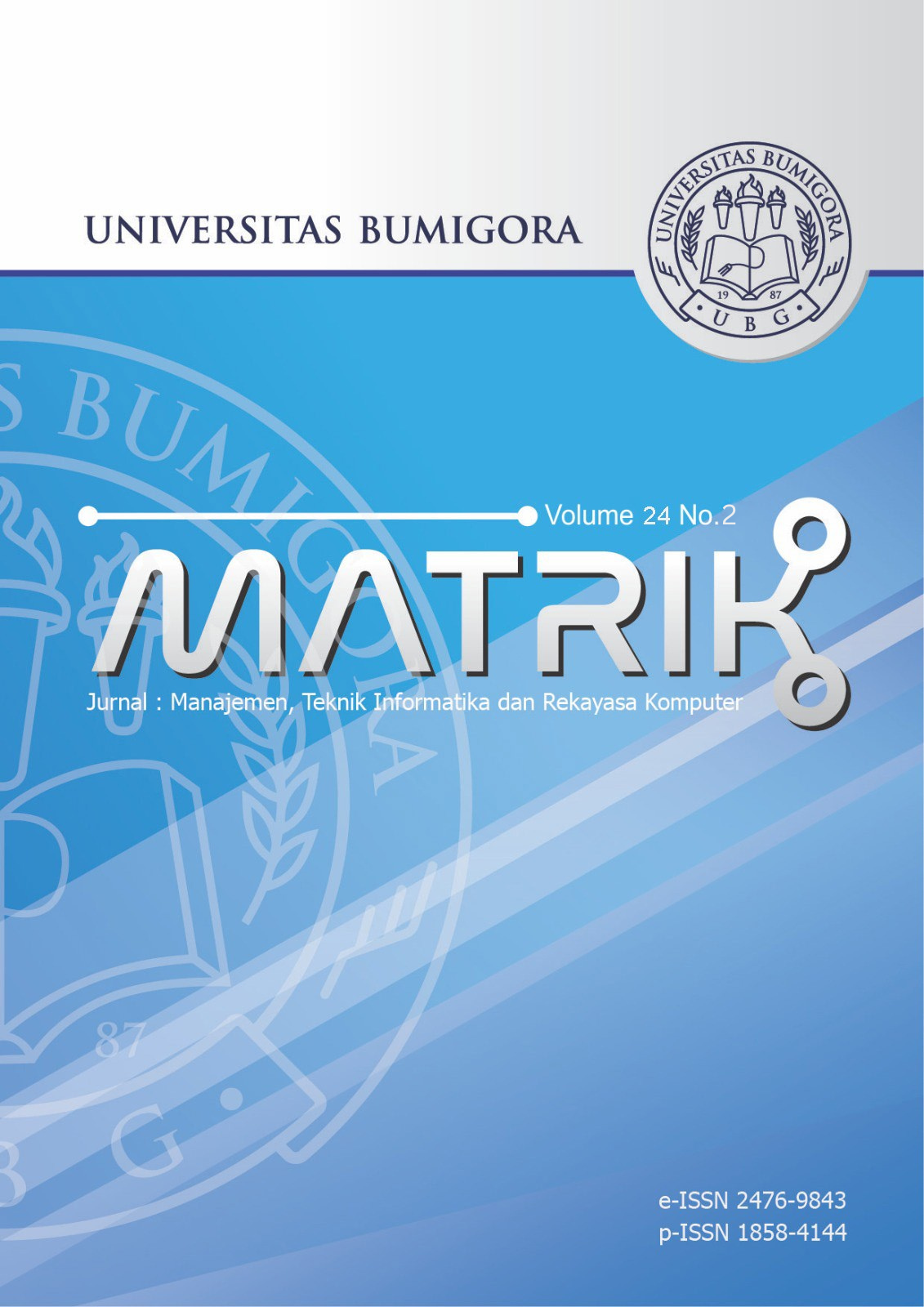Predicting Gen Z’s Sentiments on Gorontalo’s CulturalWisdom UsingSentiment Analysis Models
DOI:
https://doi.org/10.30812/matrik.v24i2.4591Keywords:
Dikili, Generation Z, Local Culture Gorontalo, Meeraji, Naive Bayes, Sentiment AnalysisAbstract
In the digital era, Generation Z faces both opportunities and challenges in understanding and preserving local cultural wisdom. It is essential to ensure that cultural values go beyond superficial consumption in cyberspace and remain deeply valued as integral aspects of identity and history. As technological advances and globalization continue influencing young people to preserve, local culture presents an increasing challenge. This study aims to determine Generation Z’s perceptions of Gorontalo’s local cultural wisdom, focusing on the Dikili and Meeraji traditions through a sentiment analysis approach. This research method uses the Naive Bayes algorithm to analyze positive, negative, and neutral sentiments derived from text data processed through a structured pre-processing stage. The findings reveal that Generation Z’s perceptions of the Dikili and Meeraji cultures are mostly positive, reflecting a strong appreciation and acceptance of these cultural values. However, the presence of negative sentiment highlights a critical view among some members of Generation Z, who consider certain aspects of these traditions less relevant or controversial in a modern context. In addition, neutral sentiment indicates a segment of young people who may need more exposure or information to form an informed opinion. The study concludes that while Dikili and Meeraji cultures still hold value among Generation Z, a more inclusive and adaptive approach to cultural preservation is needed. The findings offer valuable insights for strategies to preserve and develop local cultural heritage in the digital age.
Downloads
References
Culture: Taking Digital Media Art as an Example,†in Proceedings of the 4th International Conference on Art Studies: Science,
Experience, Education (ICASSEE 2020). Atlantis Press, 2020, pp. 578–582, https://doi.org/10.2991/assehr.k.200907.105.
[2] L. Lazzeretti, “What is the role of culture facing the digital revolution challenge? Some reflections for a research agenda,â€
vol. 30, no. 9, pp. 1617–1637, 2022-09-02, https://doi.org/10.1080/09654313.2020.1836133.
[3] A. Rahmawati, D. M. Astuti, F. H. Harun, and M. K. Rofiq, “Peran Media Sosial dalam Penguatan Moderasi Beragama di
Kalangan Gen-Z,†vol. 3, no. 5, pp. 905–920, 2023-10-02, https://doi.org/10.53625/jabdi.v3i5.6495.
[4] A. D. Murdani and H. Haqqi, “Penguatan Nilai Nasionalisme melalui Kearifan Lokal bagi Gen-Z sebagai Counter Hegemoni
Asing,†vol. 3, no. 4, pp. 236–242, 2023-12-20, https://doi.org/10.31004/jh.v3i4.366.
[5] L. Blandi, M. Sabbatucci, G. Dallagiacoma, F. Alberti, P. Bertuccio, and A. Odone, “Digital Information Approach through
Social Media among Gen Z and Millennials: The Global Scenario during the COVID-19 Pandemic,†vol. 10, no. 11, p. 1822,
2022-10-28, https://doi.org/10.3390/vaccines10111822.
[6] D. Malekpour Koupaei, T. Song, K. S. Cetin, and J. Im, “An assessment of opinions and perceptions of
smart thermostats using aspect-based sentiment analysis of online reviews,†vol. 170, p. 106603, 2020-03, https:
//doi.org/10.1016/j.buildenv.2019.106603.
[7] V. Gooljar, T. Issa, S. Hardin-Ramanan, and B. Abu-Salih, “Sentiment-based predictive models for online purchases in the era
of marketing 5.0: A systematic review,†vol. 11, no. 1, p. 107, 2024-08-05, https://doi.org/10.1186/s40537-024-00947-0.
[8] S. Thomas, Yuliana, and Noviyanti. P, “Study Analisis Metode Analisis Sentimen pada YouTube,†vol. 1, no. 1, pp. 1–7,
2021-03-02, https://doi.org/10.46229/jifotech.v1i1.201.
[9] A. A. Kharlamov and M. Pilgun, “Data Analytics for Predicting Situational Developments in Smart Cities: Assessing User
Perceptions,†vol. 24, no. 15, p. 4810, 2024-01, https://doi.org/10.3390/s24154810.
[10] R. A. Putri, N. A. A. Fitri, and S. Syamsir, “Pengaruh Globalisasi Digital terhadap Budaya di Sumatera Barat,†vol. 3, no. 9,
pp. 32–42, 2024-05-24, https://doi.org/10.6578/triwikrama.v3i9.3308.
[11] Redaksi, “Generasi z: Peran utama dalam era transformasi digital,†2024-04-10, https://langgam.id/
generasi-z-peran-utama-dalam-era-transformasi-digital/.
[12] W. B. Zulfikar, A. R. Atmadja, and S. F. Pratama, “Sentiment Analysis on Social Media Against Public Policy Using
Multinomial Naive Bayes,†vol. 10, no. 1, pp. 25–34, https://doi.org/10.15294/sji.v10i1.39952.
[13] Y. A. Singgalen, “Analisis SentimenWisatawan Melalui Data Ulasan Candi Borobudur di Tripadvisor Menggunakan Algoritma
Na¨ıve Bayes Classifier,†vol. 4, no. 3, 2022-12-26, https://doi.org/10.47065/bits.v4i3.2486.
[14] B. Liu, “Sentiment Analysis: Mining Opinions, Sentiments, and Emotions,†p. 431, 2020-10-15, https://books.google.co.id/
books/about/Sentiment Analysis.html?hl=id&id=PdX7DwAAQBAJ&redir esc=y.
[15] D. R. Daffa, D. Arthuro, J. A. Fernanda, and Muh. BintangWidya Pratama, “Gen-Z: Eksplorasi Identitas Budaya dan Tantangan
Sosial dalam Era Digital,†vol. 2, no. 2, pp. 169–183, 2024-05-08, https://doi.org/10.59581/jipsoshum-widyakarya.v2i2.3112.
[16] C. Ahmed, A. ElKorany, and E. ElSayed, “Prediction of customer’s perception in social networks by integrating sentiment
analysis and machine learning,†vol. 60, no. 3, pp. 829–851, 2023-06-01, https://doi.org/10.1007/s10844-022-00756-y.
[17] J.-Y. Huang, C.-L. Tung, and W.-Z. Lin, “Using Social Network Sentiment Analysis and Genetic Algorithm to
Improve the Stock Prediction Accuracy of the Deep Learning-Based Approach,†vol. 16, no. 1, p. 93, 2023-05-29,
https://doi.org/10.1007/s44196-023-00276-9.
[18] P. Savci and B. Das, “Prediction of the customers’ interests using sentiment analysis in e-commerce data for comparison of
Arabic, English, and Turkish languages,†vol. 35, no. 3, pp. 227–237, 2023-03, https://doi.org/10.1016/j.jksuci.2023.02.017.
[19] R. Singh and R. Singh, “Applications of sentiment analysis and machine learning techniques in disease outbreak prediction –
A review,†vol. 81, pp. 1006–1011, 2023, https://doi.org/10.1016/j.matpr.2021.04.356.
[20] R. L. Mustofa and B. Prasetiyo, “Sentiment analysis using lexicon-based method with naive bayes classifier algorithm on
#newnormal hashtag in twitter,†vol. 1918, no. 4, p. 042155, 2021-06-01, https://doi.org/10.1088/1742-6596/1918/4/042155.
[21] D. A. Kristiyanti, D. A. Putri, E. Indrayuni, A. Nurhadi, and A. H. Umam, “E-Wallet Sentiment Analysis Using Na¨ıve Bayes
and Support Vector Machine Algorithm,†in Journal of Physics: Conference Series, vol. 1641, no. 1. IOP Publishing, 2020, p.
12079, https://doi.org/10.1088/1742-6596/1641/1/012079.
[22] G. Gupta, S. Khan, V. Guleria, A. Almjally, B. I. Alabduallah, T. Siddiqui, B. M. Albahlal, S. A. Alajlan, and M. AL-subaie,
“DDPM: A Dengue Disease Prediction and Diagnosis Model Using Sentiment Analysis and Machine Learning Algorithms,â€
vol. 13, no. 6, p. 1093, 2023-03-14, https://doi.org/10.3390/diagnostics13061093.
[23] W. Gu, Y. Zhong, S. Li, C. Wei, L. Dong, Z. Wang, and C. Yan, “Predicting Stock Prices with FinBERT-LSTM: Integrating
News Sentiment Analysis,†in Proceedings of the 2024 8th International Conference on Cloud and Big Data Computing,
2024-08-15, pp. 67–72, https://doi.org/10.1145/3694860.3694870.
[24] Y. A. Sanjaya, D. Safitri, and S. Sujarwo, “Integrasi nilai-nilai kearifan lokal dalam pengembangan pendidikan karakter di era
4.0,†vol. 1, no. 2, pp. 3007–3013, 2024. https://jicnusantara.com/index.php/jicn/article/view/331
[25] N. K. N. Sari, N. K. V. S. Dewi, N. L. G. P. Maharani, N. K. G. P. Sari, D. A. M. D. Anggita, and B. R. Werang, “Membangun
Generasi Digital Bijak dan Berbudaya: Intergrasi Kearifan Lokal Bali dalam Pembelajaran Literasi Digital di SDN 5 Sudaji,â€
vol. 2, no. 3, pp. 177–194, 2024-06-14, https://doi.org/10.55927/cjas.v2i3.9717.
[26] S. Rahman, “Kearifan Lokal Huyula Masyarakat Gorontalo sebagai Media Pendidikan Anti Korupsi,†vol. 10, no. 2, pp.
148–159, 2022-09-08, https://doi.org/10.30603/tjmpi.v10i2.2792.
[27] A. Faiz and B. Soleh, “Implementasi Pendidikan Karakter Berbasis Kearifan Lokal,†vol. 7, no. 1, pp. 68–77, 2021-05-22,
https://doi.org/10.22219/jinop.v7i1.14250.
[28] S. A. Helmayanti, F. Hamami, and R. Y. Fa’rifah, “Penerapan Algoritma TF-IDF dan Na¨ıve Bayes Untuk Analisis
Sentimen Berbasis Aspek Ulasan Aplikasi Flip Pada Google Play Store,†vol. 4, no. 3, pp. 1822–1834, 2023-09-10,
https://doi.org/10.35870/jimik.v4i3.415.
[29] D. Pramudita, Y. Akbar, and T. Wahyudi, “Analisis Sentimen Terhadap Program Kartu Indonesia Pintar Kuliah
pada Media Sosial X Menggunakan Algoritma Naive Bayes: Sentiment Analysis of the Indonesian Smart College
Card Program on Social Media X Using the Naive Bayes Algorithm,†vol. 4, no. 4, pp. 1420–1430, 2024-08-05,
https://doi.org/10.57152/malcom.v4i4.1565.
[30] T. I. Alfawas, A. Rahim, and R. Rudiman, “Penerapan Fitur Ekstraksi TF-IDF untuk Analisis Sentimen Ulasan
Game Bus Simulator Indonesia dengan Algoritma Naive Bayes,†vol. 4, no. 5, pp. 3177–3193, 2024, https:
//doi.org/10.31004/innovative.v4i5.13975.
[31] G. H. A. R. Noer, “Implementasi agoritma na¨ıve bayes dan tf-idf dalam analisis sentimen data ulasan (studi kasus :
Ulasan review aplikasi e-commerce shopee di situs google playstore,†2023-04-04, https://repository.uinjkt.ac.id/dspace/handle/
123456789/68747.
Downloads
Published
Issue
Section
License
Copyright (c) 2025 Hermila A., Rahmat Taufik R. L Bau, Sitti Suhada, Abdulaziz Ahmed siyad

This work is licensed under a Creative Commons Attribution-ShareAlike 4.0 International License.
How to Cite
Similar Articles
- Akmal Setiawan Wijaya, Dhomas Hatta Fudholi, Ahmad R. Pratama, A computational approach in analyzing the empathy to online donations during COVID-19 , MATRIK : Jurnal Manajemen, Teknik Informatika dan Rekayasa Komputer: Vol. 22 No. 2 (2023)
- Anas Syaifudin, Purwanto Purwanto, Heribertus Himawan, M. Arief Soeleman, Customer Segmentation with RFM Model using Fuzzy C-Means and Genetic Programming , MATRIK : Jurnal Manajemen, Teknik Informatika dan Rekayasa Komputer: Vol. 22 No. 2 (2023)
- sayuti rahman, Marwan Ramli, Arnes Sembiring, Muhammad Zen, Rahmad B.Y Syah, Normalization Layer Enhancement in Convolutional Neural Network for Parking Space Classification , MATRIK : Jurnal Manajemen, Teknik Informatika dan Rekayasa Komputer: Vol. 23 No. 3 (2024)
- Donny Kurniawan, Anthony Anggrawan, Hairani Hairani, Graduation Prediction System on Students Using C4.5 Algorithm , MATRIK : Jurnal Manajemen, Teknik Informatika dan Rekayasa Komputer: Vol. 19 No. 2 (2020)
- Didih Rizki Chandranegara, Faras Haidar Pratama, Sidiq Fajrianur, Moch Rizky Eka Putra, Zamah Sari, Automated Detection of Breast Cancer Histopathology Image Using Convolutional Neural Network and Transfer Learning , MATRIK : Jurnal Manajemen, Teknik Informatika dan Rekayasa Komputer: Vol. 22 No. 3 (2023)
- Bambang Krismono Triwijoyo, SEGMENTASI CITRA PEMBULUH DARAH RETINA MENGGUNAKAN METODE DETEKSI GARIS MULTI SKALA , MATRIK : Jurnal Manajemen, Teknik Informatika dan Rekayasa Komputer: Vol. 15 No. 1 (2015)
- Nella Rosa Sudianjaya, Chastine Fatichah, Segmentation and Classification of Breast Cancer Histopathological Image Utilizing U-Net and Transfer Learning ResNet50 , MATRIK : Jurnal Manajemen, Teknik Informatika dan Rekayasa Komputer: Vol. 24 No. 1 (2024)
- William Barkem, Jeckson Sidabutar, Digital Forensic Analysis of WhatsApp Business Applications on Android-Based Smartphones Using NIST , MATRIK : Jurnal Manajemen, Teknik Informatika dan Rekayasa Komputer: Vol. 22 No. 3 (2023)
- Budi Sumanto, Salima Nurrahma, Comparison of Random Forest Support Vector Machine and Passive Aggressive Models on E-nose-Based Aromatic Rice Classification , MATRIK : Jurnal Manajemen, Teknik Informatika dan Rekayasa Komputer: Vol. 24 No. 3 (2025)
- Yuniansyah Yuniansyah, Andri Saputra, PENGEMBANGAN MULTIMEDIA PEMBELAJARAN UNTUK MATAKULIAH GRAFIK KOMPUTER MENGGUNAKAN METODE ADDIE , MATRIK : Jurnal Manajemen, Teknik Informatika dan Rekayasa Komputer: Vol. 17 No. 1 (2017)
You may also start an advanced similarity search for this article.


.png)












